Improved Dynamic Compressive and Electro-Thermal Properties of Hybrid Nanocomposite Visa Physical Modification
Abstract
:1. Introduction
2. Experimental and Characterization Details
2.1. Materials
2.2. Physical Modification
2.3. Specimen Fabrication
2.4. Characterizations and Measurements
2.4.1. XPS and FTIR Characterization
2.4.2. Microstructural Characterization
2.4.3. Electrical and Elastic Measurements
2.4.4. Quasi-Static Fracture Measurements
2.4.5. Dynamic Compressive Measurements
3. Results and Discussion
3.1. Modification Analysis
3.2. Quasi-Static Fracture
3.3. Dynamic Compression
3.3.1. Dynamic Stress–Strain Relationship under a Strain Rate of 500/s
3.3.2. Dynamic Stress–Strain Relationship under a Strain Rate of 1000/s
3.4. Conductive Functionalities
4. Conclusions
- (1)
- XPS and FT-IR analyses confirmed that the Triton™ X-100 molecule succussed to adsorb physically onto the CNTs surface. In addition, the suspension stability tests suggested that the steric repelling forces between the fillers and the matrix could be introduced to improve their dispersion effects;
- (2)
- Although only a total filler content of 0.5 wt% was added into the hybrid nanocomposite, the hybrid EP/CNT@X+GNPs_5/5 specimen achieved a maximum mode-I KIc of 3.12 ± 0.12 MPa·m1/2 and GIc of 3.19 ± 0.90 KJ·m2. The fractographic examination revealed rougher fracture surfaces in EP/CNT@X+GNPs nanocomposites than in their counterparts, suggesting greater energy dissipation and resistance during the crack propagation. Noting that, for the EP/CNT@X+GNPs_3/7 specimen, less CNT@X could not be combined with too much graphene to form an integrated CNT@X+GNPs system, causing the degradation of fracture properties;
- (3)
- The dynamic compressive properties were improved by increasing the ratio of CNT@X in the hybrid fillers at either 500/s or 1000/s. Herein, the EP/CNT@X+GNPs_7/3 specimen possessed an optimal reinforcement effect, the peak stress of which reached ~172.9 MPa, and its related failure strain was ~0.08% under 500/s;
- (4)
- In the case of conductive functionalities, the EP/CNT@X+GNPs_5/5 specimen showed better electro-thermal efficiency than its counterpart under an identical voltage of 70 V, and its surface temperature was over 100 °C in an infrared mode.
Author Contributions
Funding
Data Availability Statement
Acknowledgments
Conflicts of Interest
References
- Petousis, M.; Vidakis, N.; Mountakis, N.; Papadakis, V.; Tzounis, L. Three-dimensional printed polyamide 12 (PA12) and polylactic acid (PLA) alumina (Al2O3) nanocomposites with significantly enhanced tensile, flexural, and impact properties. Nanomaterials 2022, 12, 4292. [Google Scholar] [CrossRef] [PubMed]
- Mohd, N.N.; Asyraf, M.R.M.; Khalina, A.; Abdullah, N.; Sabaruddin, F.A.; Kamarudin, S.H.; Ahmad, S. Fabrication, functionalization, and application of carbon nanotube-reinforced polymer composite: An overview. Polymers 2021, 13, 1047. [Google Scholar] [CrossRef] [PubMed]
- Sutherland, L.S. A review of impact testing on marine composite materials: Part I–Marine impacts on marine composites. Compos. Struct. 2018, 188, 197–208. [Google Scholar] [CrossRef]
- Banik, A.; Zhang, C.; Khan, M.H.; Wilson, M.; Tan, K.T. Low-velocity ice impact response and damage phenomena on steel and CFRP sandwich composite. Int. J. Impact. Eng. 2022, 162, 104134. [Google Scholar] [CrossRef]
- Xian, G.; Guo, R.; Li, C.; Wang, Y. Mechanical performance evolution and life prediction of prestressed cfrp plate exposed to hygrothermal and freeze-thaw environments. Compos. Struct. 2022, 293, 115719. [Google Scholar] [CrossRef]
- Liu, B.; Vu-Bac, N.; Zhuang, X.; Fu, X.; Rabczuk, T. Stochastic full-range multiscale modeling of thermal conductivity of Polymeric carbon nanotubes composites: A machine learning approach. Compos. Struct. 2022, 289, 115393. [Google Scholar] [CrossRef]
- Ramezani, M.; Dehghani, A.; Sherif, M.M. Carbon nanotube reinforced cementitious composites: A comprehensive review. Constr. Build. Mater. 2022, 315, 125100. [Google Scholar] [CrossRef]
- Burmistrov, I.N.; Mostovoi, A.S.; Shatrova, N.V.; Panova, L.G.; Kuznetsov, D.V.; Gorokhovdkii, A.V.; Inykh, I.A. Influence of surface modification of potassium polytitanates on the mechanical properties of polymer composites thereof. Russ. J. Appl. Chem. 2013, 86, 765. [Google Scholar] [CrossRef]
- Zhang, Q.; Bai, G.; Xiao, W.; Sui, G.; Yang, X.P. Effect of amine functionalized MWCNT-epoxy interfacial interaction on MWCNT dispersion and mechanical properties of epoxy-amine composites. Polym. Compos. 2018, 39, E2552. [Google Scholar] [CrossRef]
- Uthaman, A.; Lal, H.M.; Li, C.; Xian, G.; Thomas, S. Mechanical and water uptake properties of epoxy nanocomposites with surfactant-modified functionalized multiwalled carbon nanotubes. Nanomaterials 2021, 11, 1234. [Google Scholar] [CrossRef]
- Kim, K.W.; Han, W.; Kim, B.J. Effects of Mixing ratio of hybrid carbonaceous fillers on thermal conductivity and mechanical properties of polypropylene matrix composites. Polymers 2022, 14, 1935. [Google Scholar] [CrossRef] [PubMed]
- Hameed, A.; Islam, M.; Ahmad, I.; Mahmood, N.; Saeed, S.; Javed, H. Thermal and mechanical properties of carbon nanotube/epoxy nanocomposites reinforced with pristine and functionalized multiwalled carbon nanotubes. Polym. Compos. 2015, 36, 1891–1898. [Google Scholar] [CrossRef]
- Rubel, R.I.; Ali, M.H.; Jafor, M.A.; Alam, M.M. Carbon nanotubes agglomeration in reinforced composites: A review. AIMS. Mater. Sci. 2019, 6, 756–780. [Google Scholar] [CrossRef]
- Wang, Y.; Yao, D.; He, Z.; Wang, D.; Zheng, Y. Enhanced mechanical and damping properties of epoxy using aggregated nanoparticles organic-inorganic hybrid as a filler. Compos. Interface. 2022, 29, 523–536. [Google Scholar] [CrossRef]
- Wang, F.; Zhang, K.; Liang, W.; Wang, Z.; Yang, B. Experimental and analytical studies on the flexible, low-voltage electrothermal film based on the multi-walled carbon nanotube/polymer nanocomposite. Nanotechnology 2018, 30, 065704. [Google Scholar] [CrossRef]
- Amirbeygi, H.; Khosravi, H.; Tohidlou, E. Reinforcing effects of aminosilane-functionalized graphene on the tribological and mechanical behaviors of epoxy nanocomposites. J. Appl. Polym. Sci. 2019, 136, 47410. [Google Scholar] [CrossRef]
- Kovalevskiy, N.; Svintsitskiy, D.; Cherepanova, S.; Yakushkin, S.; Martyanov, O.; Selishcheva, S.; Gribov, E.; Kozlov, D.; Selishchev, D. Visible-Light-Active N-Doped TiO2 Photocatalysts: Synthesis from TiOSO4, Characterization, and Enhancement of Stability Via Surface Modification. Nanomaterials 2022, 12, 4146. [Google Scholar] [CrossRef]
- Rennhofer, H.; Zanghellini, B. Dispersion state and damage of carbon nanotubes and carbon nanofibers by ultrasonic dispersion: A review. Nanomaterials 2021, 11, 1469. [Google Scholar] [CrossRef]
- Kerche, E.F.; Fonseca, E.; Schrekker, H.S.; Amico, S.C. Ionic liquid-functionalized reinforcements in epoxy-based composites: A systematic review. Mater. Today. Chem. 2021, 20, 100477. [Google Scholar] [CrossRef]
- Al-Gaashani, R.; Najjar, A.; Zakaria, Y.; Mansour, S.; Atieh, M.A. XPS and structural studies of high quality graphene oxide and reduced graphene oxide prepared by different chemical oxidation methods. Ceram. Int. 2019, 45, 14439–14448. [Google Scholar] [CrossRef]
- Szabo, T.; Maroni, P.; Szilagyi, I. Size-dependent aggregation of graphene oxide. Carbon 2020, 160, 145–155. [Google Scholar] [CrossRef]
- Shcherbakov, A.; Mostovoy, A.; Bekeshev, A.; Burmistrov, I.; Arzamastsev, S.; Lopukhova, M. Effect of microwave irradiation at different stages of manufacturing unsaturated polyester nanocomposite. Polymers 2022, 14, 4594. [Google Scholar] [CrossRef] [PubMed]
- Kim, S.H.; Rhee, K.Y.; Park, S.J. Amine-terminated chain-grafted nanodiamond/epoxy nanocomposites as interfacial materials: Thermal conductivity and fracture resistance. Compos. Part. B-Eng. 2020, 192, 107983. [Google Scholar] [CrossRef]
- Lavagna, L.; Nisticò, R.; Musso, S.; Pavese, M. Functionalization as a way to enhance dispersion of carbon nanotubes in matrices: A review. Mater. Today. Chem. 2021, 20, 100477. [Google Scholar] [CrossRef]
- Yang, D.; Wei, Q.; Yu, L.; Ni, Y.; Zhang, L. Natural rubber composites with enhanced thermal conductivity fabricated via modification of boron nitride by covalent and non-covalent interactions. Compos. Sci. Technol. 2021, 202, 108590. [Google Scholar] [CrossRef]
- Breitwieser, A.; Sleytr, U.B.; Pum, D. A new method for dispersing pristine carbon nanotubes using regularly arranged s-layer proteins. Nanomaterials 2021, 11, 1346. [Google Scholar] [CrossRef]
- Kulkarni, H.B.; Tambe, P.M.; Joshi, G. Influence of covalent and non-covalent modification of graphene on the mechanical, thermal and electrical properties of epoxy/graphene nanocomposites: A review. Compos. Interfaces 2018, 25, 381–414. [Google Scholar] [CrossRef]
- Goto, T.; Sakakibara, N.; Inoue, K.; Mayumi, K.; Shimizu, Y.; Ito, T.; Ito, K.; Hakuta, Y.; Terashima, K. Fabrication of flexible porous slide-ring polymer/carbon nanofiber composite elastomer by simultaneous freeze-casting and cross-linking reaction with dimethyl sulfoxide. Compos. Sci. Technol. 2021, 215, 109028. [Google Scholar] [CrossRef]
- Lee, W.; Kim, J. Improved thermal conductivity of poly (dimethylsiloxane) composites filled with well-aligned hybrid filler network of boron nitride and graphene oxide. Polym. Test. 2021, 104, 107402. [Google Scholar] [CrossRef]
- Pokharel, P.; Xiao, D.; Erogbogbo, F.; Keles, O.; Lee, D.S. A hierarchical approach for creating electrically conductive network structure in polyurethane nanocomposites using a hybrid of graphene nanoplatelets, carbon black and multi-walled carbon nanotubes. Composites, Part B 2019, 161, 169–182. [Google Scholar] [CrossRef]
- Hamze, S.; Berrada, N.; Cabaleiro, D.; Desforges, A.; Ghanbaja, J.; Gleize, J. Few-layer graphene-based nanofluids with enhanced thermal conductivity. Nanomaterials 2020, 10, 1258. [Google Scholar] [CrossRef] [PubMed]
- Kim, J.J.; Brown, A.D.; Bakis, C.E.; Smith, E.C. Hybrid carbon nanotube-carbon fiber composites for high damping. Compos. Sci. Technol. 2021, 207, 108712. [Google Scholar] [CrossRef]
- Gong, X.; Liu, J.; Baskaran, S.; Voise, R.D.; Young, J.S. Surfactant-assisted processing of carbon nanotube/polymer composites. Chem. Mater. 2000, 12, 1049–1052. [Google Scholar] [CrossRef]
- Oral, I.; Guzel, H.; Ahmetli, G. Ultrasonic properties of polystyrene-based composites. J. Appl. Polym. Sci. 2012, 125, 1226–1237. [Google Scholar] [CrossRef]
- ASTM. Standard Test Method for Tensile Properties of Plastics; ASTM International: West Conshohocken, PA, USA, 1996. [Google Scholar]
- Pham, T.M.; Davis, J.; San, H.N.; Pournasiri, E.; Shi, F.; Hao, H. Experimental investigation on dynamic properties of ultra-high-performance rubberized concrete (UHPRuC). Constr. Build. Mater. 2021, 307, 125104. [Google Scholar] [CrossRef]
- Huang, Z.; Sui, L.; Wang, F.; Du, S.; Zhou, Y.; Ye, J. Dynamic compressive behavior of a novel ultra-lightweight cement composite incorporated with rubber powder. Compos. Struct. 2020, 244, 112300. [Google Scholar] [CrossRef]
- Wepasnick, K.A.; Smith, B.A.; Bitter, J.L.; Fairbrother, D.H. Chemical and structural characterization of carbon nanotube surfaces. Anal. Bioanal. Chem. 2010, 396, 1003–1014. [Google Scholar] [CrossRef]
- Datsyuk, V.; Kalyva, M.; Papagelis, K.; Parthenios, J.; Tasis, D.; Siokou, A.; Kallitsis, I.; Galiotis, C. Chemical oxidation of multiwalled carbon nanotubes. Carbon 2008, 46, 833–840. [Google Scholar] [CrossRef]
- Chatterjee, S.; Nafezarefi, F.; Tai, N.H.; Schlagenhauf, L.; Nüesch, F.A.; Chu, B.T.T. Size and synergy effects of nanofiller hybrids including graphene nanoplatelets and carbon nanotubes in mechanical properties of epoxy composites. Carbon 2012, 50, 5380–5386. [Google Scholar] [CrossRef]
- Rathod, V.T.; Kumar, J.S.; Jain, A. Polymer and ceramic nanocomposites for aerospace applications. Appl. Nanosci. 2017, 7, 519–548. [Google Scholar] [CrossRef]
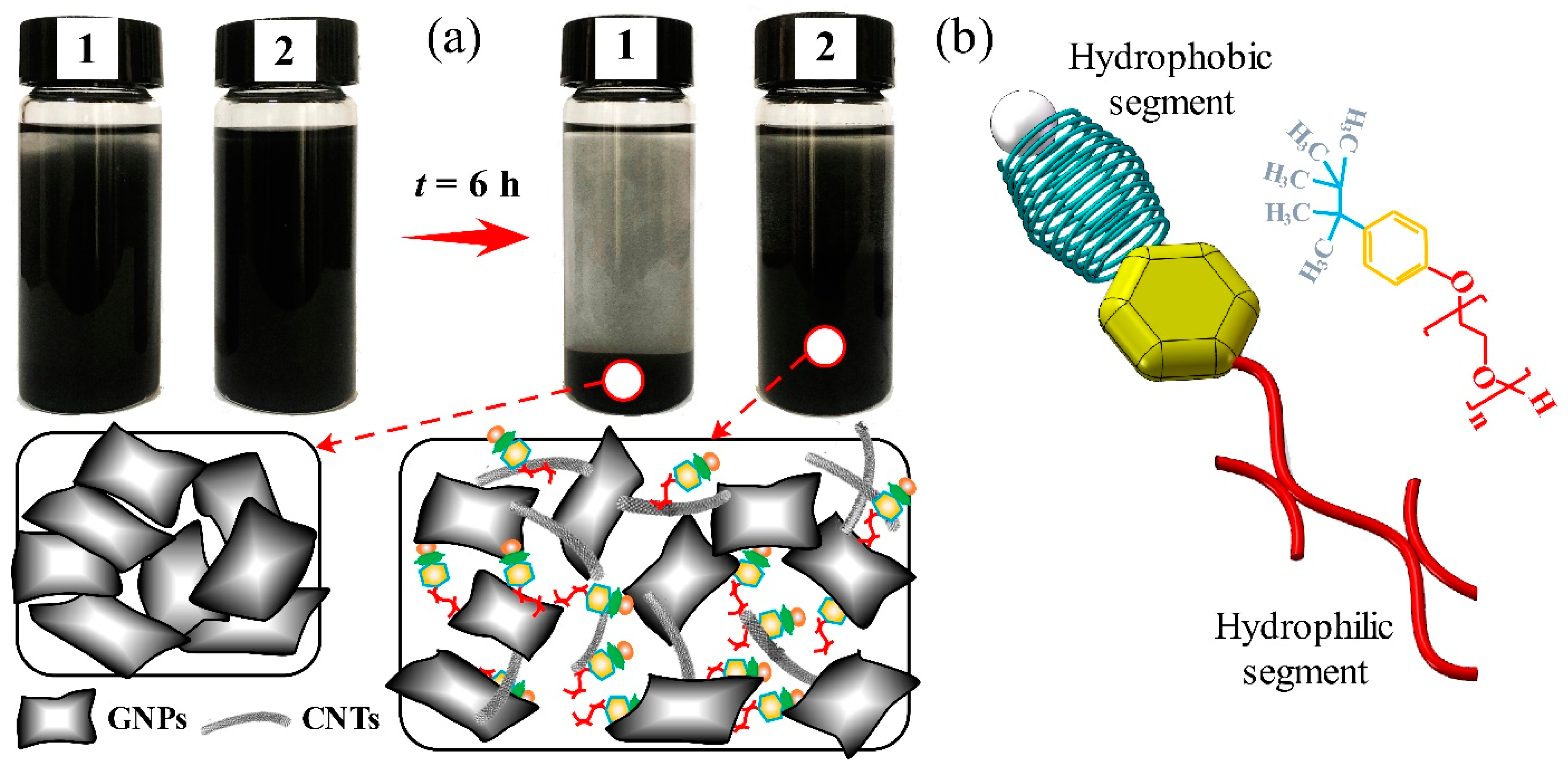
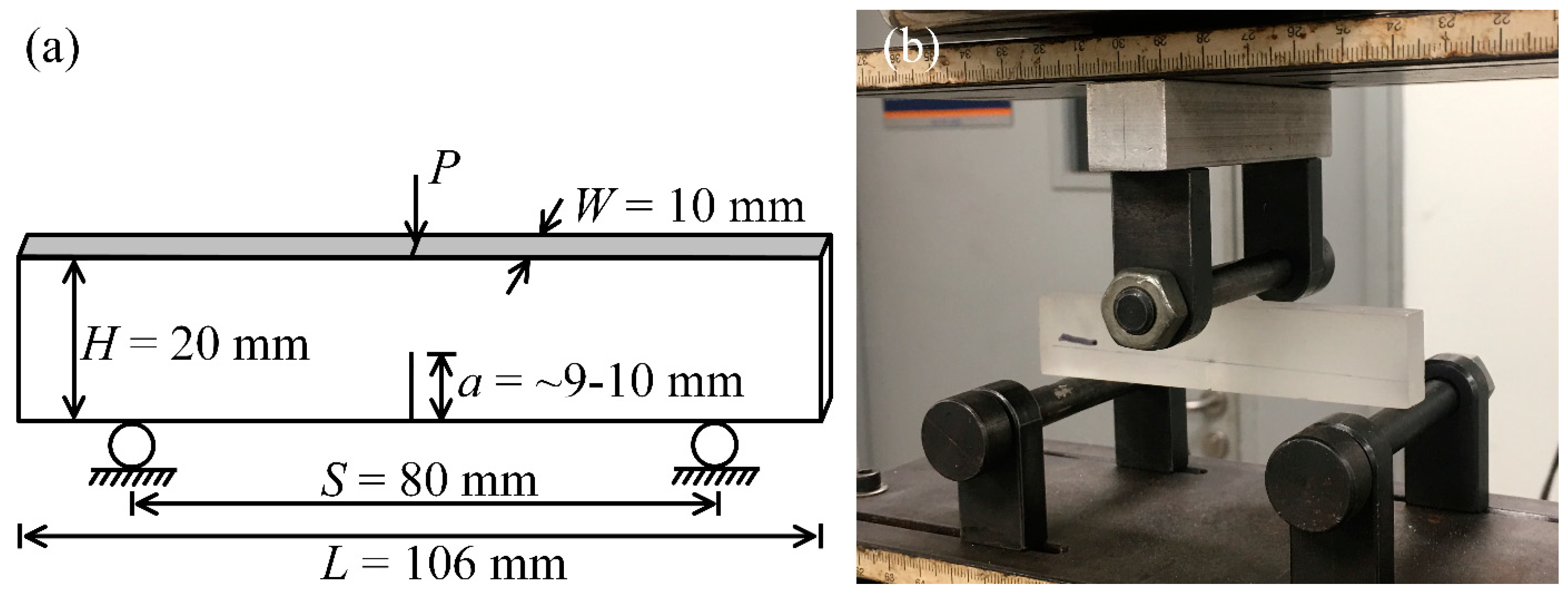


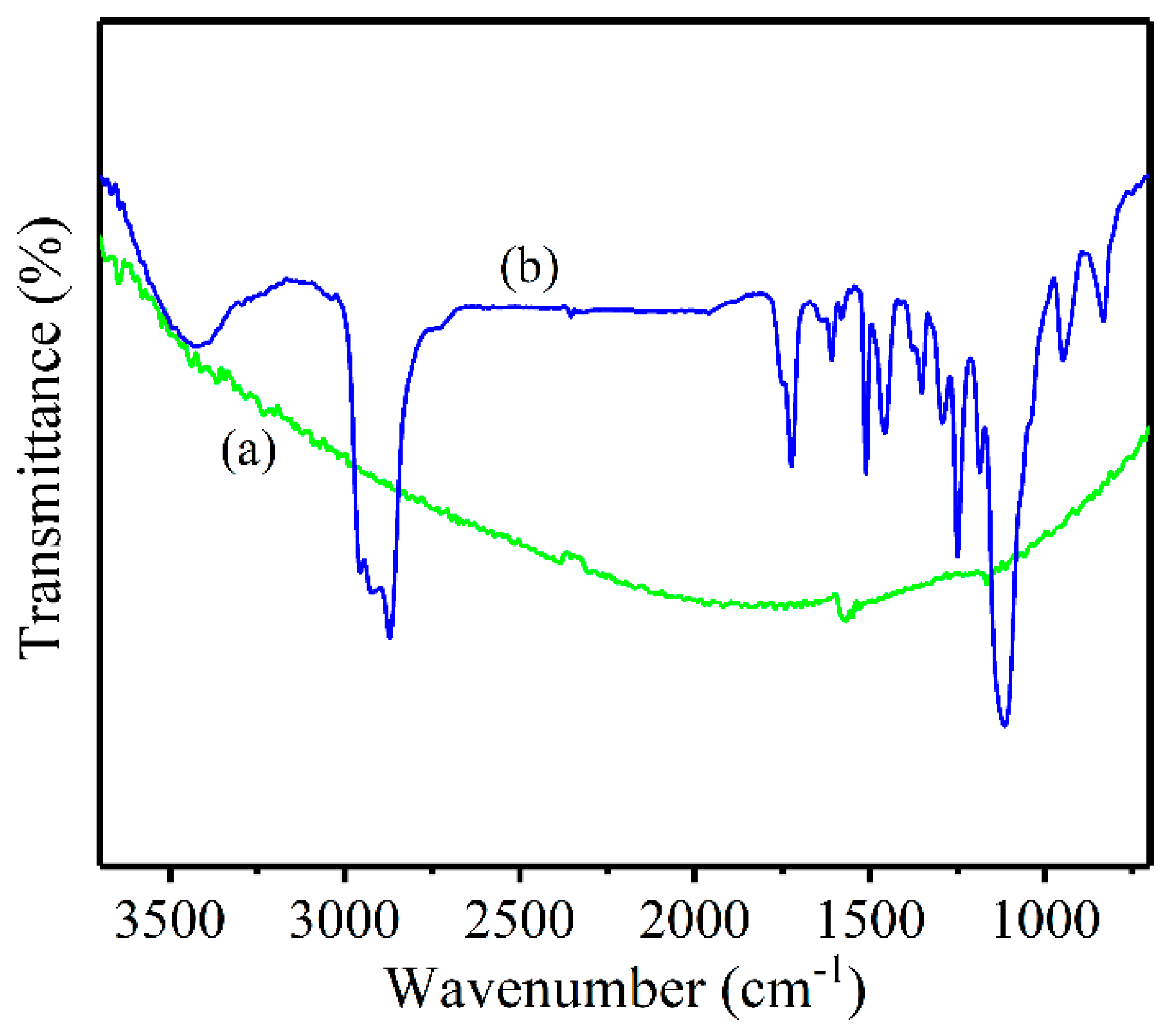
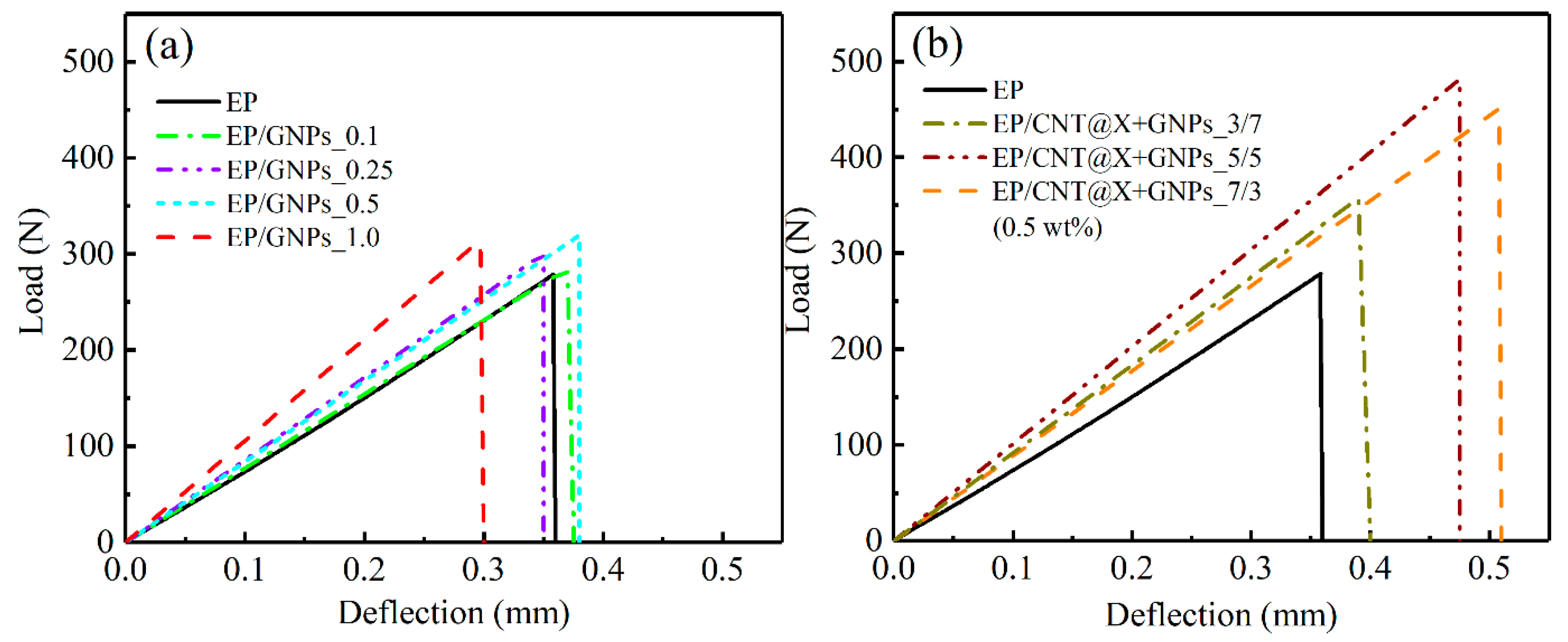

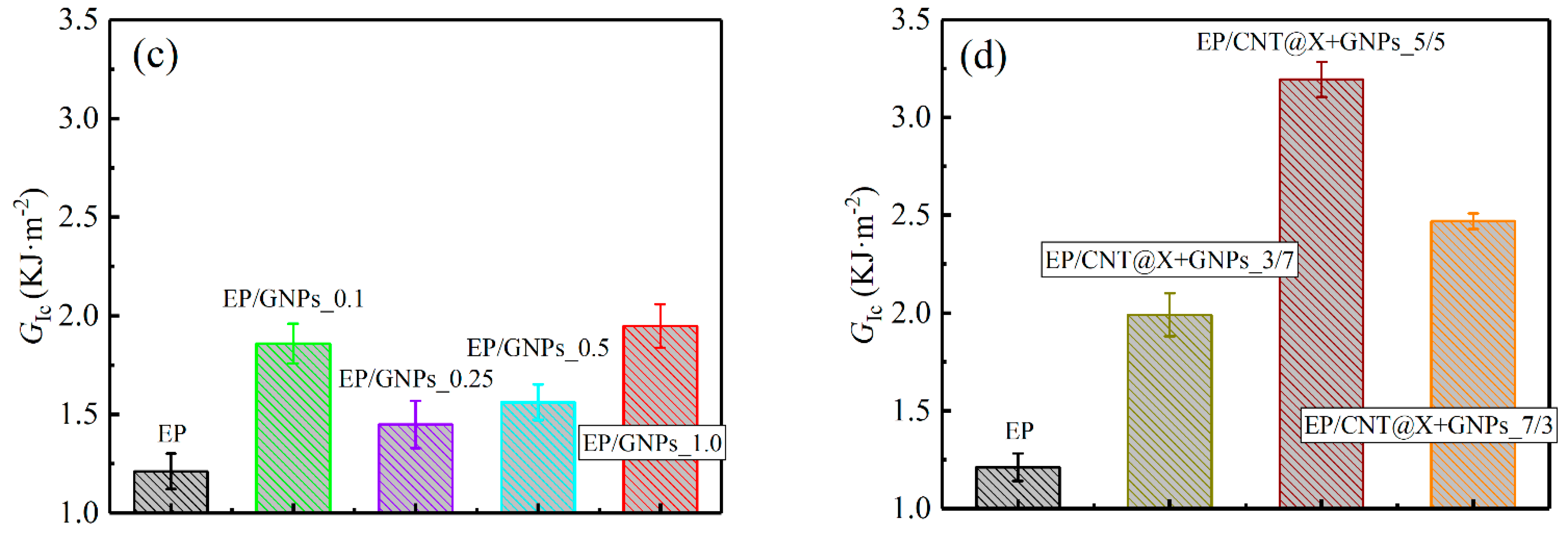

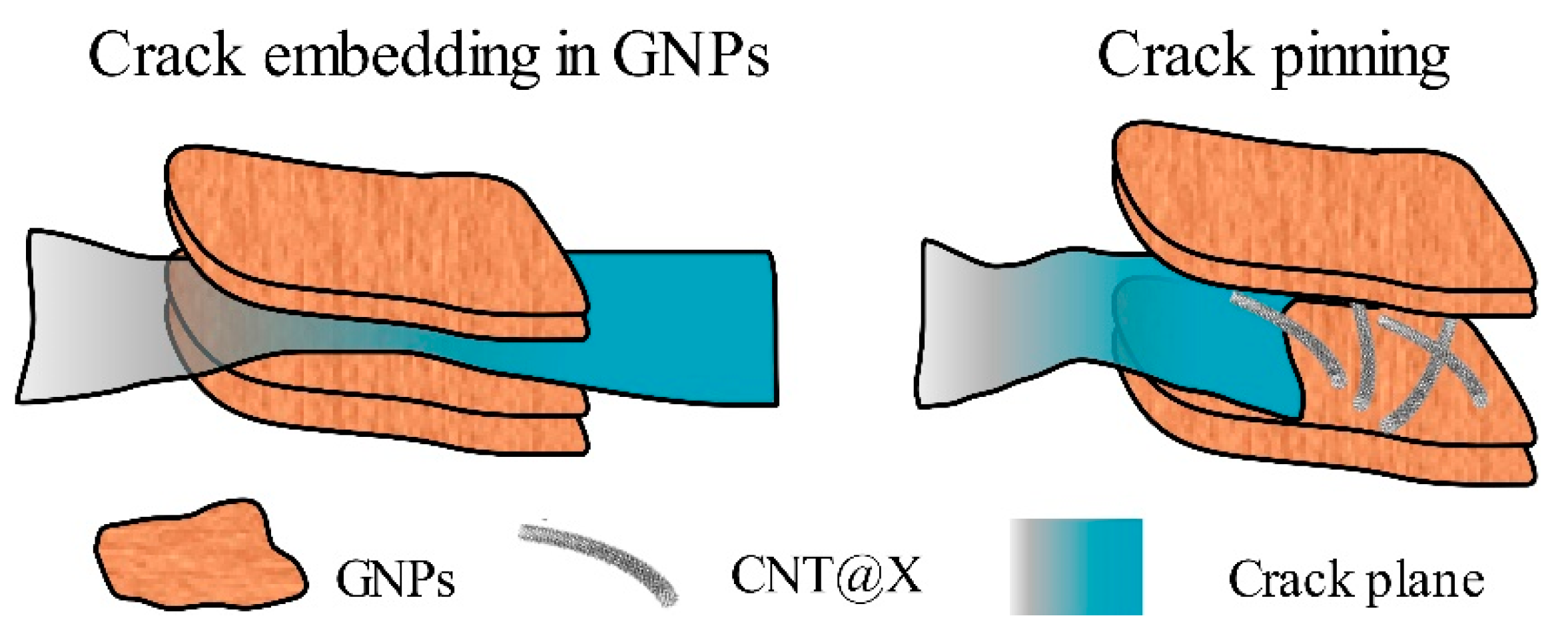

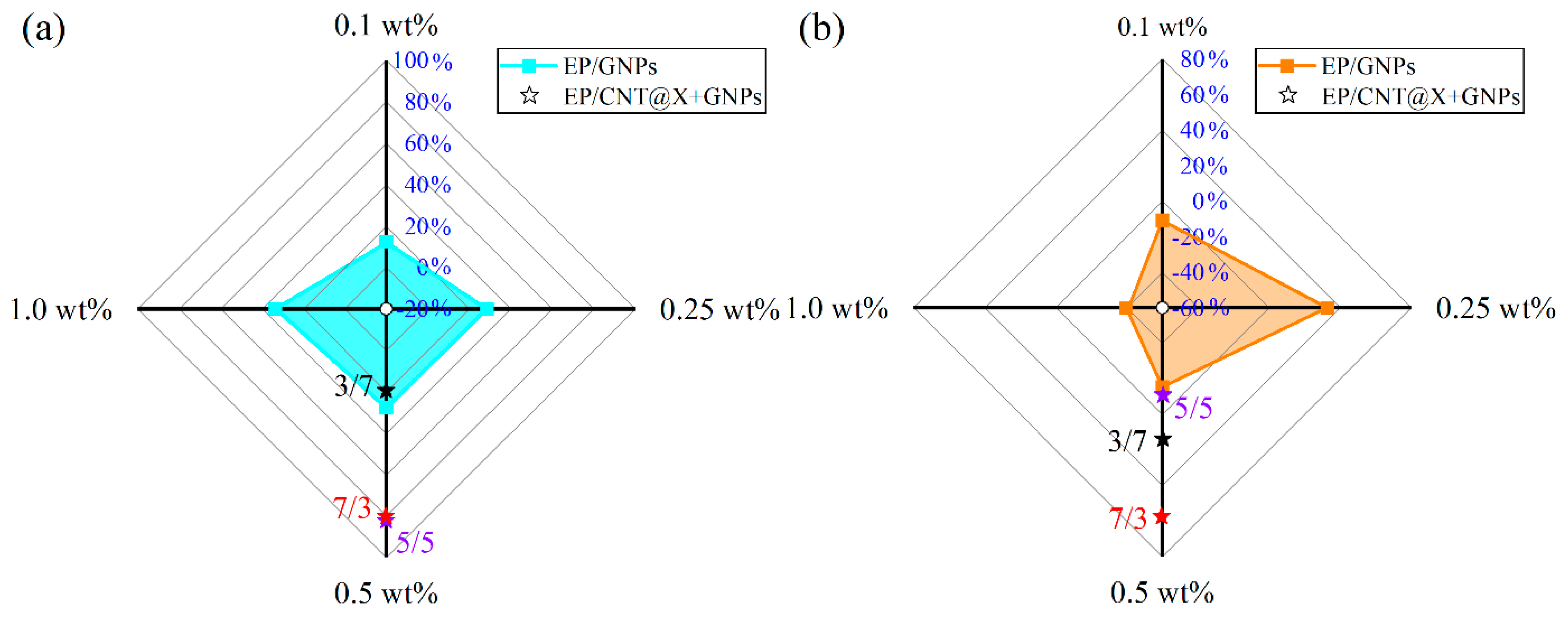


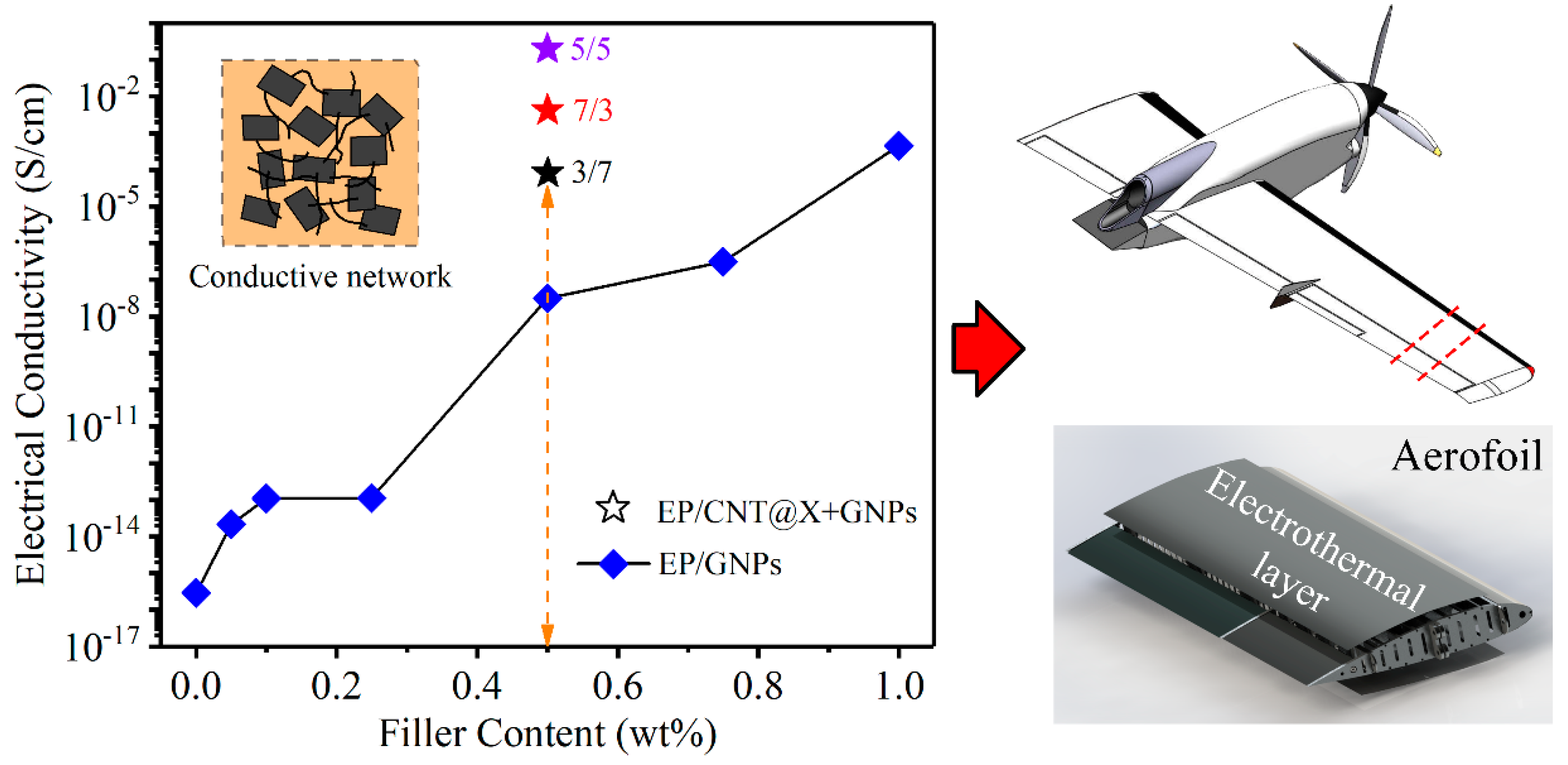
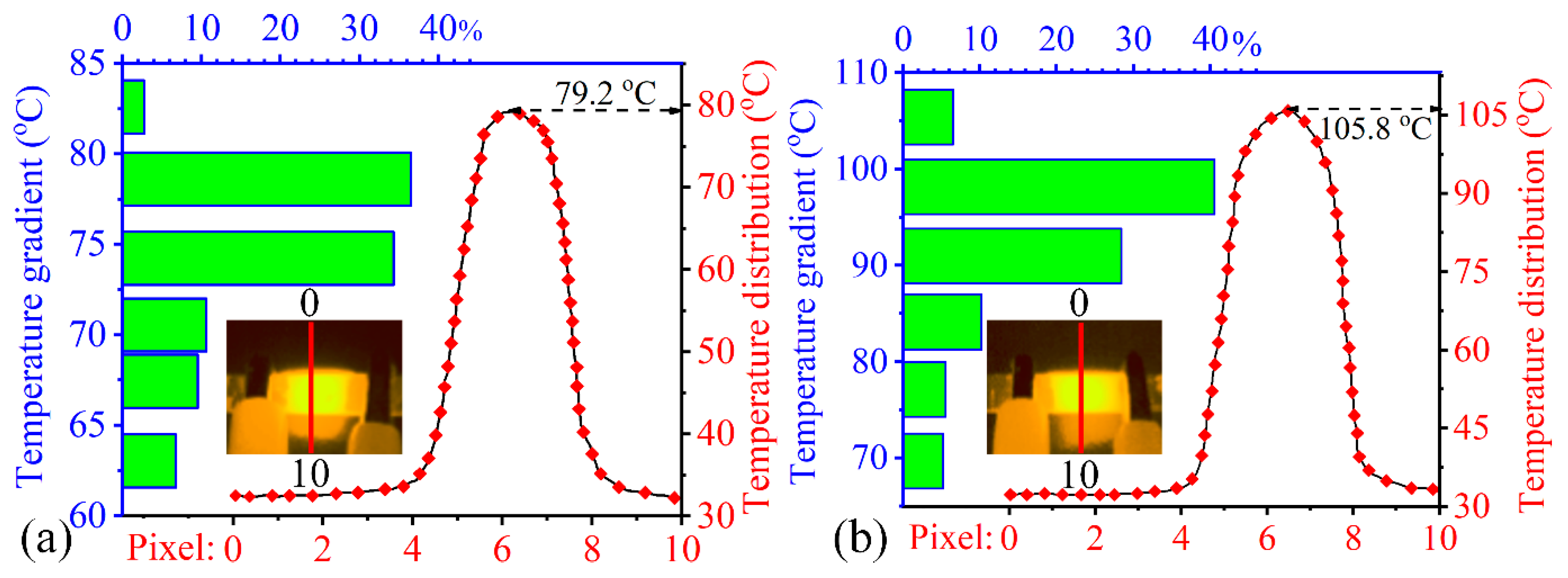
| Materials | Conductivity | Surface Area | Viscosity | Density | Form | Technology |
|---|---|---|---|---|---|---|
| GNPs | ~87 S/cm | ~732 m2/g | - | ~0.02 g/mL | Powder | CVD |
| CNTs | ~128 S/cm | ~220 m2/g | - | ~2.1 g/mL | Powder | CVD |
| Epoxy | - | - | ~7000 Mpa·s (25 °C) | ~1.3 g/cm3 | Liquid | One step synthesis |
| Hardener | - | - | ~11 Mpa·s (25 °C) | ~0.96 g/cm3 | Liquid | - |
| C 1s | O 1s | Impurities | O/C ratio | |
|---|---|---|---|---|
| GNPs | 96.61% | 2.87% | 0.52% | 0.030 |
| CNT@X+GNPs | 85.37% | 13.46% | 1.17% | 0.158 |
| Binding Energy (eV) and Assignments | |||
|---|---|---|---|
| sp2 C=C | sp3 C-C | C-O | |
| GNPs | 67.43% | 11.69% | 20.88% |
| CNT@X+GNPs | 48.27% | 23.51% | 28.22% |
| Specimens | Maximum Load | Maximum Deflection | Increment Proportion of Load | Increment Proportion of Deflection |
|---|---|---|---|---|
| EP | 279.01 N | 0.36 mm | - | - |
| EP/GNPs_0.1 | 285.45 N | 0.37 mm | 2.31% | 2.78% |
| EP/GNPs_0.25 | 300.69 N | 0.35 mm | 7.77% | −2.75% |
| EP/GNPs_0.5 | 319.84 N | 0.38 mm | 14.63% | 5.56% |
| EP/GNPs_1.0 | 314.69 N | 0.30 mm | 12.79% | −16.67% |
| EP/CNT@X+GNPs_3/7 | 357.67 N | 0.39 mm | 28.19% | 8.33% |
| EP/CNT@X+GNPs_5/5 | 481.75 N | 0.48 mm | 72.66% | 33.33% |
| EP/CNT@X+GNPs_7/3 | 450.80 N | 0.51 mm | 61.57% | 41.67% |
Disclaimer/Publisher’s Note: The statements, opinions and data contained in all publications are solely those of the individual author(s) and contributor(s) and not of MDPI and/or the editor(s). MDPI and/or the editor(s) disclaim responsibility for any injury to people or property resulting from any ideas, methods, instructions or products referred to in the content. |
© 2022 by the authors. Licensee MDPI, Basel, Switzerland. This article is an open access article distributed under the terms and conditions of the Creative Commons Attribution (CC BY) license (https://creativecommons.org/licenses/by/4.0/).
Share and Cite
Zhang, K.; Tang, X.; Guo, F.; Xiao, K.; Zheng, D.; Ma, Y.; Zhao, Q.; Wang, F.; Yang, B. Improved Dynamic Compressive and Electro-Thermal Properties of Hybrid Nanocomposite Visa Physical Modification. Nanomaterials 2023, 13, 52. https://doi.org/10.3390/nano13010052
Zhang K, Tang X, Guo F, Xiao K, Zheng D, Ma Y, Zhao Q, Wang F, Yang B. Improved Dynamic Compressive and Electro-Thermal Properties of Hybrid Nanocomposite Visa Physical Modification. Nanomaterials. 2023; 13(1):52. https://doi.org/10.3390/nano13010052
Chicago/Turabian StyleZhang, Kai, Xiaojun Tang, Fuzheng Guo, Kangli Xiao, Dexin Zheng, Yunsheng Ma, Qingsong Zhao, Fangxin Wang, and Bin Yang. 2023. "Improved Dynamic Compressive and Electro-Thermal Properties of Hybrid Nanocomposite Visa Physical Modification" Nanomaterials 13, no. 1: 52. https://doi.org/10.3390/nano13010052







